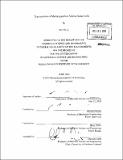Texturization of multicrystalline silicon solar cells
Author(s)
Li, Dai-Yin
DownloadFull printable version (15.03Mb)
Other Contributors
Massachusetts Institute of Technology. Dept. of Materials Science and Engineering.
Advisor
Emanuel Sachs.
Terms of use
Metadata
Show full item recordAbstract
A significant efficiency gain for crystalline silicon solar cells can be achieved by surface texturization. This research was directed at developing a low-cost, high-throughput and reliable texturing method that can create a honeycomb texture. Two distinct approaches for surface texturization were studied. The first approach was photo-defined etching. For this approach, the research focus was to take advantage of Vall6ra's technique published in 1999, which demonstrated a high-contrast surface texture on p-type silicon created by photo-suppressed etching. Further theoretical consideration, however, led to a conclusion that diffusion of bromine in the electrolyte impacts the resolution achievable with Vallera's technique. Also, diffusion of photocarriers may impose an additional limitation on the resolution. The second approach studied was based on soft lithography. For this approach, a texturization process sequence that created a honeycomb texture with 20 ptm spacing on polished wafers at low cost and high throughput was developed. Novel techniques were incorporated in the process sequence, including surface wettability patterning by microfluidic lithography and selective condensation based on Raoult's law. Microfluidic lithography was used to create a wettability pattern from a 100A oxide layer, and selective condensation based on Raoult's law was used to reliably increase the thickness of the glycerol/water liquid film entrained on hydrophilic oxide islands approximately from 0.2 pm to 2.5 pm . However, there remain several areas that require further development to make the process sequence truly successful, especially when applied to multicrystalline wafers.
Description
Thesis (Ph. D.)--Massachusetts Institute of Technology, Dept. of Materials Science and Engineering, 2010. Cataloged from PDF version of thesis. Includes bibliographical references (p. 103-111).
Date issued
2010Department
Massachusetts Institute of Technology. Department of Materials Science and EngineeringPublisher
Massachusetts Institute of Technology
Keywords
Materials Science and Engineering.